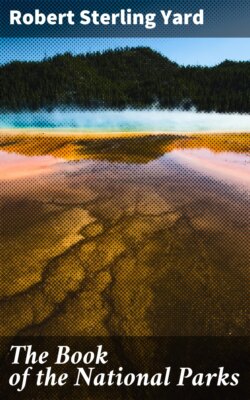Читать книгу The Book of the National Parks - Robert Sterling Yard - Страница 30
На сайте Литреса книга снята с продажи.
I
ОглавлениеWhere the lava billows of the Cascade Mountains end in northern California the granite knobs of the Sierra begin. Sharply differentiated in appearance and nature a few miles further in either direction, here their terminals overlap, and so nearly merge that the southern end of the one and the northern beginning of the other are not easily distinguished by the untrained eye.
But southward the Sierra Nevada, the snowy saw-toothed range of the Spaniards, the Sierra of modern American phrase, rapidly acquires the bulk and towering height, the craggy cirqued summits and the snowy shoulders which have made it celebrated. Gathering grandeur as it sweeps southward close to the western boundary of California, its western slopes slashed deep with canyons, its granite peaks and domes pushing ever higher above the scattering forests of its middle zones, its eastern ramparts dropping in precipices to the desert, it valiantly guards its sunny state against the passage of eastern highways, and forces hard engineering problems upon the builders of transcontinental railroads. Where it becomes the eastern boundary of the Yosemite National Park it breaks into climaxes of magnificence.
From this point on the Sierra broadens and bulks. It throws out spurs, multiplies paralleling ranges, heaps peaks and ridges between gulf-like canyons which carry roaring waters through their forested trenches. Pushing ever higher above timber-line, it breaks into large lake-bearing cirques, sometimes cirque within cirque, walled in silvery granite, hung with garlands of snow and dripping with shining glaciers. Ninety miles south of Yosemite it culminates in a close grouping of snow-daubed, glacier-gouged, lightning-splintered peaks, one of which, Mount Whitney, highest summit in the United States, raises his head just a little above his gigantic neighbors.
South of Whitney, the Sierra subsides rapidly and merges into the high plateaus and minor ranges of southern California.
Seventy-five miles of the crest of this titanic range at the climax of its magnificence, sixty-five miles of it north of Whitney and ten miles of it south, constitute the western boundary of an area of sixteen hundred square miles which Congress is considering setting apart under the title of the Roosevelt National Park; a region so particularly characterized by ruggedness, power, and unified purpose that it is eminently fitted to serve as the nation's memorial to Theodore Roosevelt. Besides its stupendous mountains, it includes the wildest and most exuberant forested canyons, and the most luxuriant groves in the United States, for its boundaries will enclose also the present Sequoia National Park, in which a million trunks of the famous Sequoia Washingtoniana cluster around the General Sherman Tree, believed to be the biggest and oldest living thing in all the world.
Wide though its range from bleak crest to warm forest, every part of this region is a necessary part of its whole. Nature's subtle finger has so knitted each succeeding zone into the fabric of its neighbors that it would be a vandal's hand which should arbitrarily cut the picture short of the full completion of its perfect composition. It is one of Nature's masterpieces, through whose extremest contrasts runs the common note of supremacy.
Whether or not, then, Congress insures its perpetuity and unified development, we can consider it scenically only as a whole.
Similar in kind to the Yosemite National Park, Roosevelt is far ruggeder and more masterful. It will be the national park of superlatives. Yet each of these similar areas is a completed unit of striking individuality. Yosemite, taking its note from its incomparable Valley, never will be equalled for sheer beauty; Roosevelt knows no peer for exuberance and grandeur. Yosemite will remain Mecca for the tourist; Roosevelt will draw into its forest of giant trees, and upon its shoulders of chiselled granite, thousands of campers-out and lovers of the high trail.
Joined near the crest of the Sierra by the John Muir Trail, California's memorial to her own prophet of the out-of-doors, these two national parks, so alike and yet so different, each striking surely its own note of sublimity, are, in a very real sense, parts of one still greater whole; the marriage of beauty and strength.
